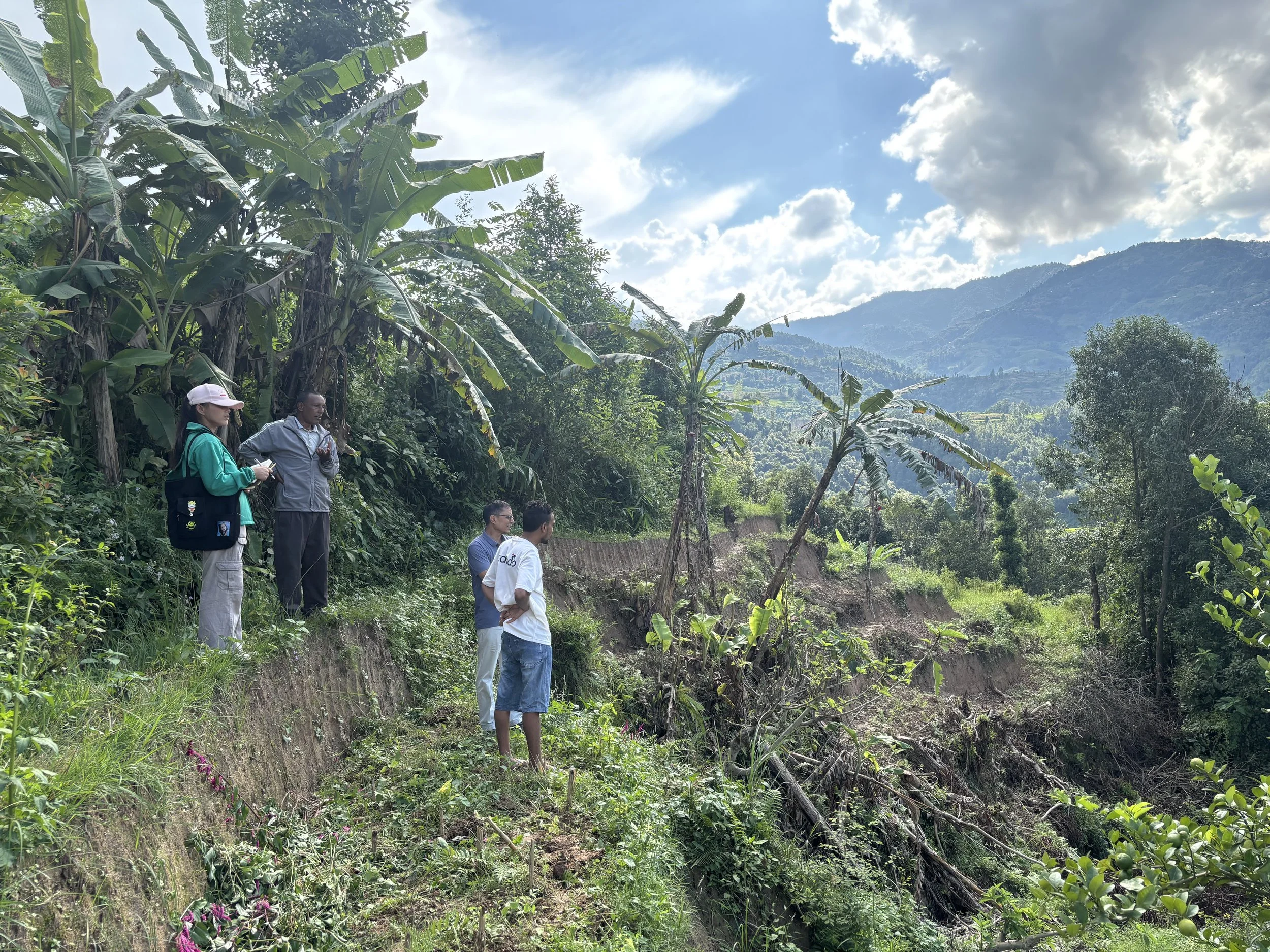This October, I returned to Nepal to visit our partners and project communities in Kavrepalanchok, Nawalparasi and Solukhumbu. Across each region, I saw powerful examples of how people are adapting to a changing climate — rebuilding from disaster, transforming farming practices, and strengthening community resilience in the face of uncertainty.
Rebuilding Resilience in Kavrepalanchok
In Mandandeupur, the landscape still bears the deep scars of the devastating floods and landslides that struck in 2024. Whole hillsides were swept away, homes lost and farmland buried. Yet just a year on, the recovery is remarkable.
Farmers have reshaped damaged terraces and stabilised fragile slopes with trees and deep-rooted vegetation. Small ponds have been built to capture and redirect runoff during heavy rains, reducing erosion and creating vital water sources for dry periods. These community-led efforts are restoring both the land and people’s confidence in their future.
In one particularly moving example was Ram, a farmer who lost his home, his family and much of his land, has begun to rebuild from scratch — planting hundreds of lemon and lychee trees to bind the soil and renew his livelihood. Across the region, this spirit of determination is echoed everywhere.
The adaptation extends beyond recovery. Villages are embracing more climate-smart, organic approaches to farming. In Gurung, farmers are experimenting with natural pest control to reduce reliance on chemicals, while in Kaldevi a new water system now brings safe drinking water and reliable irrigation — a huge step in coping with erratic rainfall and drought. On the hills of Chandani Mandan, a collective lemon plantation is thriving, providing both income and erosion control. Together, these efforts show how climate resilience can grow directly from community innovation and local knowledge.
Growing Climate Solutions in Nawalparasi
In Nawalparasi, coffee is proving to be one of the region’s most powerful tools for climate change adaptation. Once dominated by traditional subsistence crops, the hills around Dhobadi and Baseni are now home to thriving coffee agroforestry systems that combine productivity with protection for the land.
Farmers are learning to manage shade and soil health, creating microclimates that help coffee trees and companion crops thrive even as rainfall patterns shift. Coffee’s deep roots help stabilise the soil, while intercropping with vegetables, legumes and fruit trees keeps the land fertile and diverse. These changes are improving incomes and nutrition while building long-term resilience to drought and disease.
The social dimension of adaptation here is equally inspiring. Women are taking the lead in farmer groups and training sessions, while local schools are helping young people understand the connection between climate, land and livelihoods. It’s a grassroots movement that blends environmental restoration with empowerment — one that’s already changing lives and landscapes.
Sustaining Progress in Solukhumbu
Further east in Solukhumbu, adaptation has been a long journey — one that began more than a decade ago through The Glacier Trust’s first partnership with EcoHimal. Today, those years of investment are really bearing fruit. Coffee and agroforestry systems have become part of daily life, providing both stability and opportunity in a region increasingly affected by climate shifts.
Farmers are protecting coffee trees with carefully managed shade, planting diverse crops to restore soil fertility, and integrating livestock to recycle nutrients. The Agro-Forestry Resource Centre continues to play a central role, maintaining a remarkable diversity of tree species that support reforestation and sustainable land use.
The roastery at Mukli, now showing new momentum following technical training, represents another vital step — keeping more value within the community and strengthening the local economy. This combination of ecological and economic adaptation is helping Solukhumbu’s communities face the future with confidence and self-reliance.
Adapting for the Future
From the landslide-scarred slopes of Kavrepalanchok to the vibrant coffee fields of Nawalparasi and the high valleys of Solukhumbu, this visit showcased the many faces of climate change adaptation in Nepal.
What unites them is a shared sense of purpose: communities leading their own response to a changing climate. Through practical innovation, shared learning and long-term partnership, they are proving that adaptation is not just about survival — it’s about transformation.
The Glacier Trust is proud to stand alongside, and support, these communities as they rebuild, replant and reimagine what sustainable mountain living can be. With every visit, we see more clearly that adaptation grows best when rooted in local knowledge, nurtured by collaboration, and guided by hope.




